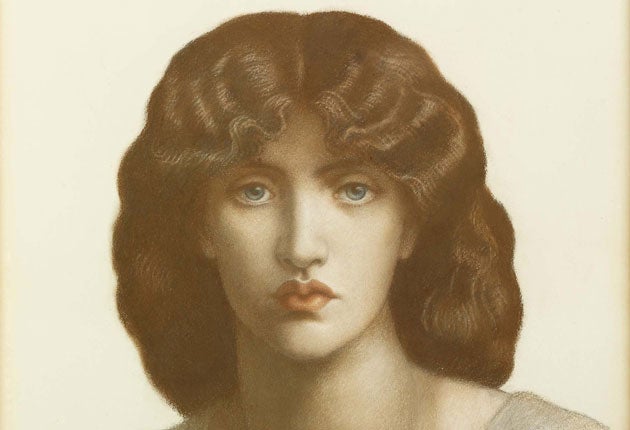The Desperate Romantics – as never seen before
The largest exhibition of Pre-Raphaelite drawings ever held includes unseen works and highlights the movement's extraordinary legacy. Terry Kirby has a sneak preview

Victorian society was outraged by their rejection of convention, but the Pre-Raphaelites became one the most influential art movements in British history. Now many of their works – most never or rarely seen in public – are to feature in an exhibition of almost 300 works at the Birmingham Museum and Art Gallery.
The movement's leading artists were racked by sexual obsession, tragedy and drug addiction. Yet using models discovered from among the poor, they created an accepted ideal of English feminine beauty.
In a special preview of The Poetry of Drawing, The Independent on Sunday was shown the largest exhibition of Pre-Raphaelite drawings and watercolours ever staged, taken from the 2,000-plus works in the gallery's archive.
Colin Cruise, the exhibition's curator, said the show would reinforce the image of the Brotherhood as both "revolutionary and traditional". He said: "We have fallen in love with their story because they were anti-establishment and reacted against the prevailing artistic orthodoxy. Yet they have become revered as symbols of a uniquely British art movement.''
The Brotherhood was formed in 1848 by Dante Gabriel Rossetti, William Holman Hunt and John Everett Millais. "They rejected the highly stylised attitude of the Royal Academy, and wanted a more fundamental true-to-life approach," said Mr Cruise, who teaches art at the University of Aberystwyth. Despite this, most of their work was highly romantic and drew on imagery from mythology, Arthurian legends, the Bible and medieval history.
One of the most striking images was found by Mr Cruise in a private collection. Rossetti's study for his painting Mnemosyne is a drawing of a Jane Morris, one of two muses who help define the "Pre-Raphaelite look". Painted in 1876, it has never been shown in public.
From a poor background, Morris entranced the Brotherhood and she married the designer William Morris. Rossetti became obsessed with her, painting her many times."She was the mother of all muses,'' Mr Cruise said.
Rossetti had earlier married Elizabeth Siddal, the Brotherhood's other great model, a milliner who went on to paint and write. She was the model for Millais' painting of Ophelia's suicide. The exhibition features a pencil study of Siddal's head for the painting. Mr Cruise added: ''It is one of the most beautiful British drawings.''
Despite the success of their artistic union, the marriage collapsed under the weight of drug addictions: Siddal died from a laudanum overdose after giving birth to a second stillborn child.
As well as the Brotherhood's works, the exhibition features followers – such as Morris, founder of the Arts and Crafts movement, and the designer Edward Burne-Jones – and those who were later influenced by them, such as the illustrator Aubrey Beardsley.
After a few brief tumultuous years, the Brotherhood burned itself out – Rossetti declining into decadence, Hunt pursuing religion and Millais taking the route into portrait-painting respectability. "Their lasting legacy," Mr Cruise said, "is that you can rebel against convention, and yet, like the Beatles, still remain widely loved."
The Poetry of Drawing runs from 29 January to 15 May
Edward Burne-Jones
Phyllis and Demophoon, 1870
This watercolour, inspired by Chaucer and ancient mythology, depicts Phyllis, Queen of Thrace, emerging from the almond tree she has been turned into when her lover, Demophoon, returns
John Everett Millais
The Head of Elizabeth Siddal, 1852. Ophelia, 1852
Millais' Ophelia is possibly the best known of the Brotherhood's works. Siddal had to lie in the bath for Millais to capture the correct lie of her head
Dante Gabriel Rossetti
Study of Jane Morris for Mnemosyne, 1876. Mnemosyne, 1881
The model for the Greek goddess was William Morris's wife, Jane, who modelled often for the Brotherhood. Rossetti wrote to his mother that the head was particularly important
William Morris
Design for a printed textile, 1882-83
Morris's Arts and Crafts movement relied on traditional craftsmanship and materials to bring the beauty of exceptional design into the everyday. Thus he created wallpaper, tile and textile designs, such as this typical example
John Everett Millais
Retribution, 1854
Millais ignored the romantic past for a series of 11 contemporary scenes illustrating sin and temptation. This shows a man being caught out in an attempt at bigamy
Edward Burne-Jones
Study of a seraph for Le Chant d'Amour, 1868. Le Chant d'Amour, 1877
The title comes from an old Breton song collected by Burne-Jones's wife, Georgiana. This painting was a great success when first exhibited in 1878
Edward Burne-Jones
The Knight's Farewell, 1858
One of several intricate pen and ink drawings which marked Burne-Jones's development as an artist. The drawing was made after a collaboration with Rossetti on the Morte d'Arthur
Aubrey Beardsley
Young Knight, c1892
Beardsley was deeply influenced by the Pre-Raphaelites and looked to the romantic past for inspiration. This pen and ink drawing shows an idealised knight and owes more to medieval romance than Victorian industrialism
Ford Maddox Brown
Study for The Last of England, 1852. The Last of England, 1855
Maddox Brown was closely associated with the Pre-Raphaelites – Rossetti had asked him to be his tutor. This painting shows an emigration to Australia. The models are Brown himself, his wife Emma, and their children
William Holman Hunt
Study for the heads of Christ and Mary for The Finding of the Saviour in the Temple, 1856
A Brotherhood founder, Hunt wanted to revitalise religious art by looking back at the early Renaissance. This painting shows Christ teaching as a child
Subscribe to Independent Premium to bookmark this article
Want to bookmark your favourite articles and stories to read or reference later? Start your Independent Premium subscription today.

Join our commenting forum
Join thought-provoking conversations, follow other Independent readers and see their replies